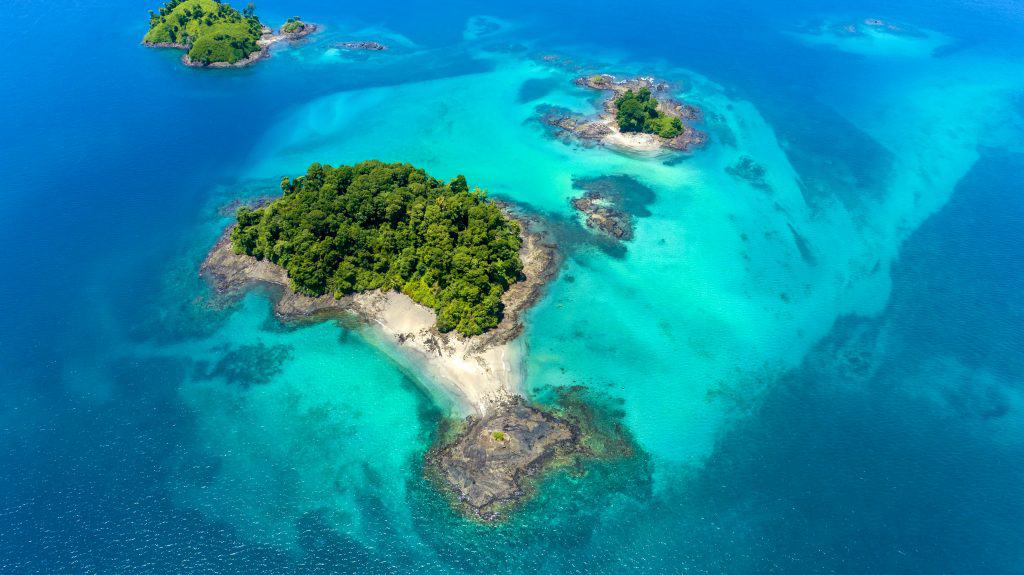One of the most exciting and amazing nature’s spectacles, it’s taking place every year from July until the end of October in Panama, when numerous families of humpback whales swim with their fins, such large wings, in the Panamanian Pacific’s waters, in their extensive journey, two months and more than 8,000 kilometers, from the South Pole escaping the harsh Arctic winter. And when we thought that the show ends, his relatives from the north arrive from January to March. Panama is one of the few places in the world where there is the possibility of appreciating both migratory groups.
For this reason, the coasts and archipelagos of Panama become a “Marine Resort and Maternity Room” for these great Panamanian and at the same time a highly attractive tourist destination for thousands of visitors who witness this extraordinary and sublime nature’s spectacle.

Humpbacks Wales are Competitive and Romantic
Scientifically known by the name of Megaptera Novaeangliae, the humpback whales travel from the poles, swimming in the Pacific Coast to the Panamanian waters for mating. The dance of love, adorned with jumps and pirouettes of the males, seeking to attract the attention of the females, who choose who they join and mate with, seeking to preserve the species.
In addition to their aquatic acrobatics, whales fall in love singing, especially humpbacks. This characteristic is most fascinates us and links us with them, it is considered the most complex song in the animal kingdom, a song can last from 15 to 30 minutes.
Humpback whales are known for their magical songs, which travel for great distances through the world’s oceans. Songs can be heard 20 miles (30 km) away, under the water.
Males can sing love serenades, in chorus, as a single voice, repeating the song several times, for days in search of their mate during this time. This is proof of your great intelligence. Songs gradually change from year to year.
The Best Places for Whale Watching in Panama
In Panama, you can find certain spots where these cetaceans can be seen, such as the Coiba National Park, Gulf of Montijo, Cebaco Island, Pedasí, Iguana Island as well as the Perls Archipelago, called since colonial times because of the existence of these jewels in its turquoise waters.
Humpback whales and their calf (babies) can also be seen in the Gulf of Chiriquí, San Miguel, Taboga Island, Panama Bay, and in part of the Chocó region, in the Darien province, bordering Colombia.
The Panamanian’s Pacific waters are a perfect space for the breeding of these marine mammals, since being warm, safe, and far from predators, they favor the reproduction, health, and well-being of their offspring.
For these aquatic mammals, the birth ritual is of utmost importance since the whales are born with no fat in their body, therefore they would not withstand the freezing temperatures of the Poles, where they feed.

Humpback whales are the world’s greatest acrobats
Coiba National Park, located in the south of the province of Veraguas, in the center of the country, is considered one of the favorite places of these majestic creatures. Inside the park, they are protected and comfortable raising and teaching their young to swim.
Did you know that … In the first year of life, a baby whale, called calves, can gain around 90 kg per day and consume about 600 liters of milk every day? What would you do with such a hungry son? Their mother’s milk is 45 to 60 percent fat content.
The calves nurse for almost a year, though they double their length in the first year, calves keep growing until they are 10 years old.
Veraguas’ Coast and Coiba are home to other types of cetacean species in addition to the humpback whale, such as orcas, the tropical spotted dolphin, the bottlenose dolphin, and other marine species worth knowing such as the whale shark, the tiger shark, the manta ray and the lovely sea turtles.
Whale Tourism and Conservation
Take advantage of the Whale Watching Tour, to discover one of the many islands and paradisiacal beaches that we have in Panama, adorned with large palm trees, white sand, crystal clear waters, and practicing snorkeling swimming among colorful fish, it is the perfect complement to your adventure.

Recently the humpback whale population dropped 90%, almost to the point of extinction, we must help protect these beautiful animals, which are still threatened by human ambition and pollution. You can help with actions as simple as avoiding throwing waste into the streets and reducing single-use plastics.
Remember, Humpback Whales are as Panamanian as we are.
Therefore, tasks such as those carried out by organizations such as Greenpeace, MarViva, and the Albatros Media Foundation, which since its inception has carried out innovative educational campaigns to increase environmental awareness, throughout Latin America are fundamental, in these times it is vital to have a clear conscience environmental and live in harmony with nature and all species on the planet.
Special thanks to Eduardo Estrada (@eestrada_wildlifephoto) for such excellent photos.

